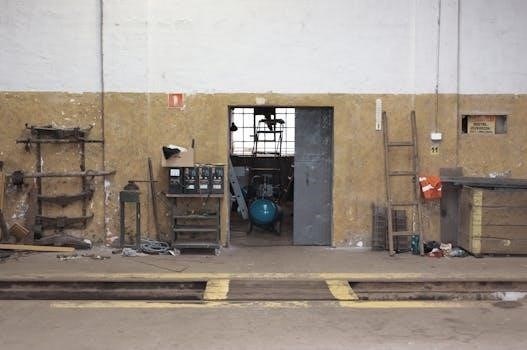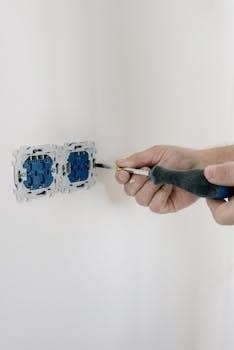how to manually engage ac compressor

Manually engaging an AC compressor clutch can be useful when troubleshooting or testing your car’s air conditioning system․ This involves directly powering the compressor to bypass the car’s control system․ This action may be needed when the compressor isn’t activating on its own․ It’s a helpful technique for diagnosing issues․
Understanding the AC Compressor Clutch
The AC compressor clutch is a vital component that controls when the compressor engages and disengages․ It’s essentially an electromagnetic coupling that connects the compressor pulley to the compressor shaft․ When the clutch is engaged, the pulley, driven by the engine belt, then rotates the compressor shaft, initiating the cooling process․ The clutch uses an electromagnetic coil to pull the clutch plate against the pulley, which creates a mechanical link․ Understanding this mechanism is crucial for manually engaging it for testing or troubleshooting purposes when the normal engagement process fails․
Why Manually Engage the AC Compressor?
Manually engaging the AC compressor is useful for diagnosing system issues․ It helps to determine if the compressor itself is functional․ This can help isolate problems with electrical controls or other components․ It’s a troubleshooting tool․
Troubleshooting AC System Failures
When your car’s AC isn’t working, manually engaging the compressor can help pinpoint the source of the problem․ If the compressor engages when manually powered, it indicates the issue likely lies within the car’s electrical system or control mechanisms, such as a faulty relay or low Freon level․ If it does not engage, this could suggest a problem with the compressor itself, such as a bad clutch or internal damage․ This method helps you isolate the problem efficiently without needlessly replacing parts․ This troubleshooting method can save time and money․
Testing Compressor Functionality
Manually engaging the AC compressor is a direct method to verify its functionality․ By applying power directly, you can determine if the compressor’s clutch engages and the shaft rotates․ A successful manual engagement confirms that the compressor itself is operational and not the source of the AC system failure․ This test helps differentiate between a faulty compressor and other issues like electrical problems or insufficient refrigerant․ It’s a crucial step in diagnosing whether the compressor is capable of doing its job, or if it needs replacement․ This helps ensure you don’t replace a functioning compressor․

Methods for Manual AC Compressor Engagement
Several methods exist to manually engage an AC compressor․ These include using a fused jumper wire or bypassing the relay with a paperclip․ These methods allow direct power to the compressor, bypassing normal controls․
Using a Fused Jumper Wire
A fused jumper wire is a safe way to manually engage the AC compressor clutch․ Connect one end of the wire to the compressor’s wire connector, specifically on the compressor side․ Then, attach the other end to the positive terminal of the car’s battery․ This action will directly supply voltage to the compressor clutch, causing it to engage, without having to switch on the air conditioning system․ The fuse protects the system from over current․
Bypassing the Relay with a Paperclip
Bypassing the AC compressor relay with a paperclip is another method to manually engage the clutch․ First, identify the AC compressor relay within the fuse box․ Carefully remove the relay and then use a bent paperclip to bridge the correct terminals within the relay socket․ This action completes the circuit, directly powering the compressor clutch and causing it to engage․ This method should be done with caution․ It’s a quick way to test compressor functionality․

Safety Precautions
When manually engaging the AC compressor, prioritize safety․ Be aware of electrical hazards and potential component damage․ Always avoid contact with moving parts․ Proceed with caution and if unsure, seek professional help․
Avoiding Electrical Hazards
When manually engaging an AC compressor, it’s crucial to be extremely cautious about electrical hazards․ Always disconnect the battery before working on any electrical components of your vehicle․ Use insulated tools and avoid touching any exposed wires․ Never work with a power source if you’re not comfortable with it․ Ensure the jumper wire is correctly fused to prevent shorts and potential electrical damage․ If you are unsure about any step, seek guidance from a qualified mechanic to prevent injury and ensure a safe procedure․ Improper handling can cause significant damage or harm․
Preventing Damage to Components
Care must be taken to prevent damage to components when manually engaging an AC compressor․ Ensure the system has sufficient refrigerant, as running the compressor without enough can lead to damage․ Also, ensure the compressor has sufficient oil․ Avoid prolonged manual engagement, as the system isn’t designed to run constantly․ If the compressor is not turning freely, forcing engagement can cause more harm․ Always check the compressor before any action․ Ensure any jumper wires are of the correct gauge to avoid overheating or causing shorts․ Never bypass safety switches, as they exist to protect the system․ If you hear any unusual noises, stop the procedure immediately․
Checking System Before Manual Engagement
Before manually engaging your AC compressor, verify refrigerant (Freon) levels and check the compressor oil․ These steps are vital to prevent damage during manual activation․ Sufficient lubrication and refrigerant are crucial for proper operation․
Ensuring Sufficient Refrigerant (Freon)
Before attempting to manually engage the AC compressor, it’s crucial to ensure that the system has adequate refrigerant, commonly known as Freon․ A low refrigerant level can prevent the compressor clutch from engaging automatically and can also lead to compressor damage if manually engaged without enough refrigerant for lubrication․ A system that is low on freon will not engage the compressor, as a safety precaution․ Check the pressure readings with a manifold gauge set to make sure the system is properly charged before manual activation․
Verifying Compressor Oil Level
Prior to manually engaging the AC compressor, it is vital to verify the oil level within the compressor․ Proper lubrication is essential for its smooth operation and longevity․ Insufficient oil can cause the compressor to seize or sustain damage upon manual engagement․ While some systems have a sight glass to check oil level, others may require draining and refilling to the correct specification․ This is a critical step as a lack of lubrication can lead to significant damage․ Always ensure adequate oil is present before manually engaging the compressor․

Identifying AC Compressor Components
Before manual engagement, you must identify key components․ These include the clutch, pulley, and wire connector․ The clutch is the part that engages the compressor shaft․ Proper identification is crucial for correct manual activation․
Locating the Clutch and Pulley
The AC compressor clutch and pulley are typically found at the front of the engine, driven by the serpentine belt․ The pulley is a freely rotating wheel, and the clutch is the component in the center that engages with the pulley․ When the system is off, the center portion, the clutch, remains stationary․ When engaged, the clutch will lock onto the pulley and rotate․ Visual inspection can help identify the clutch and pulley for manual activation․ These parts are crucial for the compressor operation․
Identifying the Compressor Wire Connector
The compressor wire connector is usually located near the AC compressor, often connected to the clutch․ It’s an electrical connector that provides power to engage the clutch․ This connector will typically have one or two wires leading to it․ Carefully examine the area around the compressor for a connector with wires going towards the compressor․ You may need to trace wires from the compressor to find the connector․ This connector is essential for manually providing power for clutch engagement, and you will need to access it to manually activate the system․
Understanding the Engagement Process
When the AC compressor clutch engages, you will typically hear a distinct “click” sound․ Additionally, the compressor shaft will start rotating․ This indicates that the compressor is now actively working and the system is engaged․
Recognizing the ‘Click’ Sound
A key indicator of successful AC compressor clutch engagement is a noticeable “click” sound․ This click signifies that the clutch has magnetically pulled the armature plate against the pulley․ This physical connection allows the engine’s rotational force to be transferred to the compressor․ The sound is usually quite distinct, allowing you to confirm that the electrical signal has reached the clutch and the mechanical engagement has occurred․ The sound may be subtle but should be clearly audible when you listen closely to the compressor area․
Observing Compressor Shaft Rotation
After hearing the engagement click, visually confirming the compressor shaft’s rotation is crucial․ With the clutch engaged, the central portion of the compressor pulley should begin to spin․ This rotation confirms that the compressor is being driven by the engine․ If the pulley is turning, but the central shaft is not, the clutch might be slipping, or there may be an internal compressor issue․ Careful observation is key to verifying that the engagement is complete and the compressor is functioning․ This can be done by directly looking at the center of the pulley․

Potential Problems and Solutions
Even with manual engagement, issues may arise․ A blocked refrigerant circuit or clutch problems can prevent proper operation․ Addressing these requires troubleshooting steps and possibly component replacement․ Always check for sufficient refrigerant levels and compressor oil․
Addressing a Blocked Refrigerant Circuit
A blocked refrigerant circuit is a common issue preventing AC compressor engagement, even when manually activated․ This blockage can stem from a variety of causes, like a malfunctioning expansion valve or a restriction within the lines․ When this occurs, the compressor might struggle to build pressure, inhibiting proper function․ Attempting manual engagement might not resolve the issue․ In such instances, it is crucial to identify and address the blockage․ This may involve inspecting, cleaning, or replacing the faulty component․ Professional assistance may be needed for complex blockages․
Troubleshooting Clutch Issues
If the AC compressor clutch fails to engage, even with manual activation, it indicates potential clutch-specific problems․ Common issues include a faulty clutch coil, which may not be creating a magnetic field, or a worn-out clutch plate․ Inspecting the clutch for physical damage and testing the coil’s resistance can help diagnose these issues․ If the clutch is worn or the coil is defective, replacement will be necessary․ It’s also important to check for any loose connections or damaged wiring that may be preventing the clutch from working correctly․
Additional Considerations
Manually engaging the AC compressor should be a temporary diagnostic step․ If issues persist, seek professional help․ Consider alternative activation methods for testing purposes․ Remember, safety is paramount during this process․
When to Seek Professional Help
If manually engaging the AC compressor does not resolve your cooling issues, or if you are uncomfortable with electrical work, it’s time to consult a professional․ Persistent problems may indicate deeper issues within the system, such as a faulty compressor, a blocked refrigerant circuit, or a damaged clutch․ Attempting complex repairs without proper knowledge can lead to more costly damage․ A certified mechanic has the tools, training, and experience to accurately diagnose and fix any AC system malfunctions safely and efficiently․ Remember, your safety and the integrity of your vehicle’s systems are paramount․
Alternative Methods of Compressor Activation
Besides directly applying power, there are alternative methods to activate the AC compressor․ One approach involves using a scan tool to command the compressor on, allowing for controlled testing and diagnostics․ Some vehicles also have a manual override through the climate control system settings, though these are less common․ Another method involves applying power directly at the relay, which may sometimes be a safer approach․ These methods can provide a more controlled way to test the compressor while minimizing the risk of damaging other electrical components․ It is vital to refer to your vehicle’s specific repair manual to understand the proper procedures․